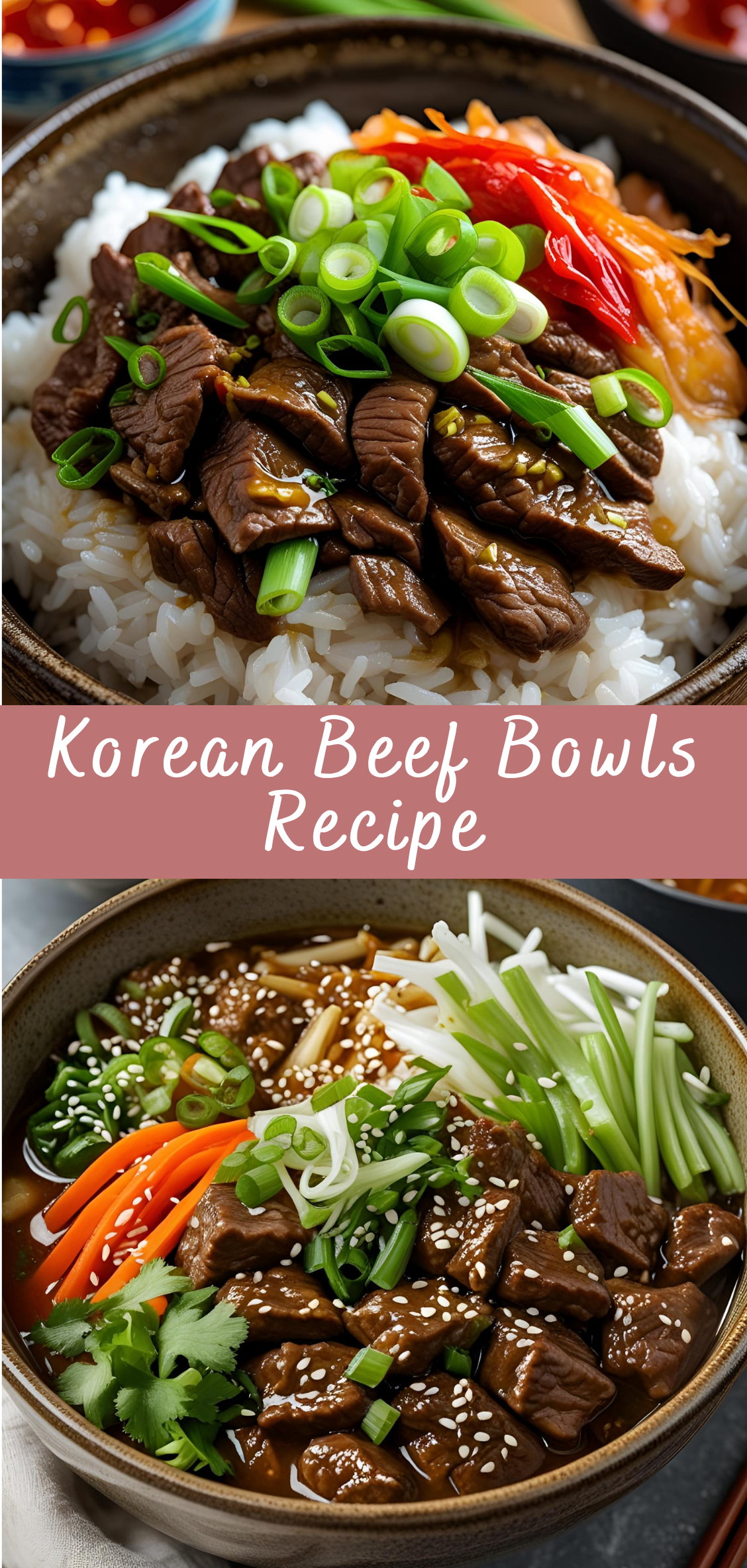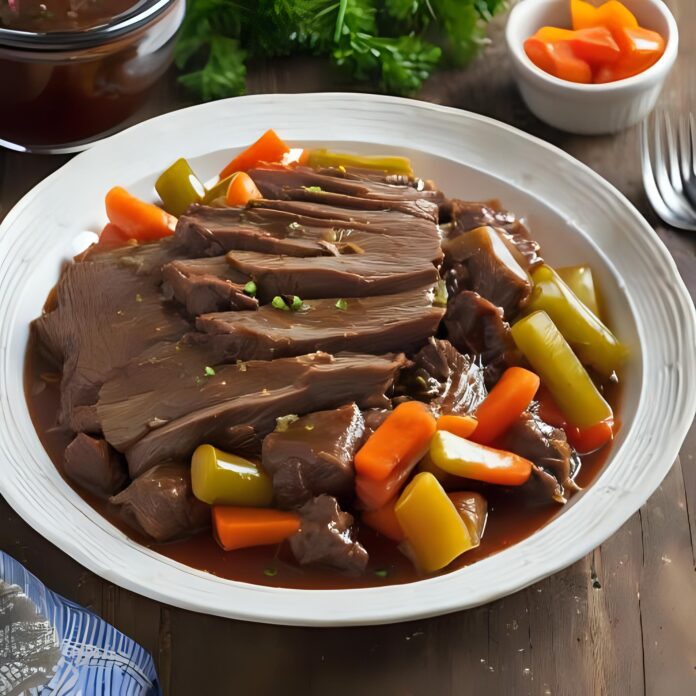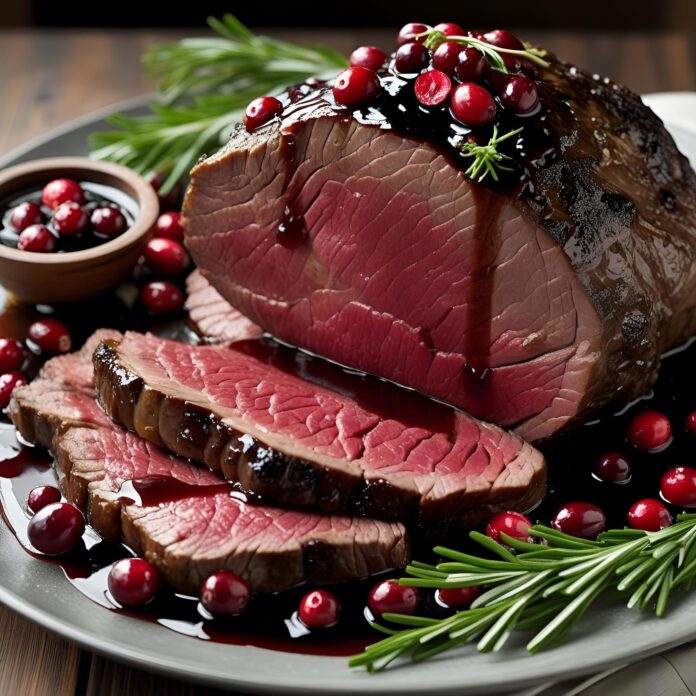Korean Beef Bowls Recipe
In the ever-evolving world of home cooking, few dishes have achieved such a rapid rise in popularity as the Korean Beef Bowl. At once simple and deeply flavorful, it embodies everything people crave from a quick, modern meal: bold taste, minimal prep, and total satisfaction. Whether you’re an adventurous eater exploring the breadth of Korean cuisine or someone seeking a new weeknight favorite, Korean beef bowls offer a delicious entry point into the world of Korean-inspired home cooking.

At its most essential, the Korean beef bowl (often modeled after bulgogi, Korea’s iconic marinated beef dish) consists of thinly sliced or ground beef cooked in a savory-sweet soy-based sauce, then served over a bed of hot rice, often accompanied by vegetables, scallions, sesame seeds, and a fried egg. But within this simple format lies incredible depth: garlic, ginger, sesame oil, sugar, soy, and gochujang (Korean chili paste) all come together to create a flavor that is at once comforting, exciting, and addictive.
A Dish Born of Tradition—And Reinvention
The roots of Korean beef bowls trace back to bulgogi, which literally translates to “fire meat.” Traditionally, bulgogi is made with thinly sliced beef (often ribeye or sirloin) marinated in a mixture of soy sauce, sugar, sesame oil, garlic, and pear juice. The meat is grilled or pan-cooked, developing an irresistible caramelized edge that captures the balance of savory, sweet, and umami-rich flavor that defines much of Korean cuisine.
But in modern kitchens—especially those outside Korea—the bulgogi bowl has evolved. Time-pressed cooks have streamlined the dish by swapping out thinly sliced cuts for ground beef, replacing time-intensive marinating with quick pan sauces, and building meals around the fast, affordable bowl format. What once required careful slicing and overnight marinating can now be made in 20 to 30 minutes, without sacrificing flavor. This innovation has helped popularize Korean beef bowls worldwide, particularly among home cooks looking for quick meals that don’t skimp on taste.
Why the Korean Beef Bowl Captivates
Part of the Korean beef bowl’s charm lies in its versatility. It’s a blank canvas ready to be personalized. Want to add vegetables? Toss in shredded carrots, steamed broccoli, or sautéed spinach. Craving spice? Gochujang, kimchi, or red chili flakes bring the heat. Watching carbs? Serve it over cauliflower rice or wrapped in lettuce leaves. From college students to busy parents to culinary enthusiasts, nearly anyone can adapt the Korean beef bowl to suit their lifestyle, dietary preferences, or mood.
The ingredients, too, are widely accessible. Ground beef is affordable and easy to cook. Soy sauce, brown sugar, and garlic are pantry staples. Sesame oil and rice vinegar may already live in your cabinet from past stir-fries or marinades. Even Korean-specific items like gochujang and kimchi are now available in most grocery stores, thanks to the growing global appreciation of Korean cuisine.
But accessibility doesn’t make it ordinary. On the contrary, Korean beef bowls deliver an elevated eating experience with relatively little effort. Every bite offers contrast—tender meat and fluffy rice, sweet and salty sauce, rich umami and bright, acidic notes from garnishes. It’s a dish that wakes up the palate without overcomplicating the process.
A Modern Bowl with Cultural Roots
In Korean cuisine, rice bowls aren’t just a trend—they’re a centuries-old tradition. Meals in Korean households are typically served with rice at the center, surrounded by various side dishes (banchan) such as kimchi, seasoned spinach, marinated tofu, or pickled radish. What makes the modern Korean beef bowl different is its all-in-one structure: a layered, composed meal designed for speed and convenience, especially for today’s fast-paced lifestyles.
This “bowl” style of eating also resonates deeply with global food trends. Just as burrito bowls, poke bowls, and grain bowls have swept through health-conscious and fast-casual kitchens, Korean beef bowls fit naturally into this pattern. They’re nutrient-rich, endlessly customizable, and ideal for meal prep—yet they maintain a sense of culinary authenticity through their roots in traditional Korean flavor profiles.
More Than Just a Meal
For many home cooks, the Korean beef bowl represents more than a quick dinner. It’s an introduction to a broader culinary tradition—an invitation to explore the ingredients, techniques, and cultural practices of Korean food. Making your first Korean beef bowl might lead you to try kimchi-making, experiment with ssamjang (Korean dipping sauce), or explore the history of Korean fermentation and grilling.
It’s also a gateway into cooking with confidence. Because the recipe is so forgiving, it empowers beginner cooks to experiment with sauces, seasonings, and plating styles. And because it’s endlessly adaptable, it provides an easy canvas for meal prep, family dinners, date nights, or late-night cravings.
Step-by-Step Instructions: Making Korean Beef Bowls
TWO APPROACHES, ONE FLAVORFUL DESTINATION
The Korean Beef Bowl is versatile enough to be made in more than one way. This guide will walk you through both:
-
Option 1: Sliced Beef Bulgogi Bowl – more traditional, made with marinated thinly sliced beef.
-
Option 2: Ground Beef Bowl – quick, budget-friendly, and ideal for weeknight cooking.
Let’s begin with the more traditional version for those seeking authenticity, then move to the modernized ground beef version afterward.
OPTION 1: TRADITIONAL-STYLE BULGOGI BEEF BOWL
Step 1: Select and Prepare Your Beef
Best Cuts:
-
Ribeye (most traditional)
-
Sirloin
-
Flank steak
-
Top round (budget-friendly)
Prep Instructions:
-
Use a very sharp knife to slice the beef into thin strips—about ⅛ to ¼ inch thick.
-
For easier slicing, freeze the beef for 30–45 minutes first.
-
Trim any large pieces of fat or sinew.
Pro Tip: Thin slices allow for quick cooking and better absorption of marinade. Think “hotpot thin.”
Step 2: Make the Marinade
In a mixing bowl, combine:
-
5 tablespoons soy sauce
-
2 tablespoons brown sugar
-
1 tablespoon sesame oil
-
1 tablespoon grated ginger
-
3 cloves garlic, minced
-
1 tablespoon rice vinegar or mirin
-
2 teaspoons gochujang (optional, for heat and depth)
-
1 teaspoon toasted sesame seeds
-
½ grated Asian pear or apple (adds sweetness and tenderizes)
-
2 scallions, thinly sliced
Whisk everything together until the sugar dissolves and the mixture smells aromatic.
Flavor Note: The combination of soy, sugar, garlic, and sesame is the heart of bulgogi. The pear/apple provides enzymes that tenderize meat naturally.
Step 3: Marinate the Beef
-
Place the thinly sliced beef in a resealable bag or shallow container.
-
Pour the marinade over the beef and toss to coat evenly.
-
Cover and refrigerate for at least 1 hour, ideally 4–6 hours, or overnight.
Quick Tip: If you’re in a hurry, even 30 minutes will infuse flavor—but longer is always better.
Step 4: Cook the Beef
Method A: Stove Top (Recommended)
-
Heat 1 tablespoon neutral oil in a large skillet or cast-iron pan over medium-high heat.
-
Remove beef from marinade (do not shake off all the marinade) and cook in batches to avoid overcrowding.
-
Sear beef for 1–2 minutes per side until just cooked and slightly caramelized.
-
Repeat with remaining meat. Combine all cooked beef in the pan for a final 30 seconds to reheat.
Why batches? Crowding the pan causes steaming instead of browning, which dulls flavor and texture.
Method B: Grill or Broiler (Optional)
-
Skewer thin slices of beef or place on grill grates.
-
Grill for 2–3 minutes per side until charred and cooked through.
Step 5: Prepare the Bowl Components
Base options:
-
Steamed white rice (short grain or jasmine)
-
Brown rice or quinoa (for a healthier twist)
-
Cauliflower rice (for low-carb option)
Topping Suggestions:
-
Julienned carrots
-
Sliced cucumbers
-
Sautéed spinach
-
Kimchi
-
Fried or soft-boiled egg
-
Gochujang mayo or Sriracha drizzle
-
Toasted sesame seeds and chopped green onions
Assembly Tip: Arrange toppings in sections around the beef for visual appeal. Finish with egg and garnish last.
OPTION 2: QUICK & EASY GROUND BEEF KOREAN BOWL
Perfect for weeknights, this version captures the essence of bulgogi with faster cooking and simpler prep.
Step 1: Ingredients
For the beef:
-
1 lb ground beef (80/20 or leaner)
-
1 tablespoon sesame oil
-
3 garlic cloves, minced
-
1 teaspoon freshly grated ginger (optional but recommended)
For the sauce:
-
¼ cup low-sodium soy sauce
-
2 tablespoons brown sugar (or honey)
-
1 tablespoon rice vinegar or mirin
-
1–2 teaspoons gochujang or Sriracha (adjust to spice level)
-
1 teaspoon cornstarch (optional, for thickening)
Garnish:
-
Green onions
-
Sesame seeds
-
Optional: shredded nori (dried seaweed)
Step 2: Cook the Ground Beef
-
Heat a large skillet over medium-high heat.
-
Add 1 tablespoon sesame oil, then ground beef.
-
Brown the beef, breaking it apart with a wooden spoon.
-
When mostly cooked through, add minced garlic and ginger.
-
Sauté together for 2–3 minutes until fragrant and beef is no longer pink.
Step 3: Add the Sauce
-
Whisk together soy sauce, brown sugar, vinegar, gochujang, and optional cornstarch.
-
Pour into skillet with beef.
-
Simmer for 3–5 minutes until sauce thickens slightly and coats the meat.
Optional Veggies: Stir in shredded carrots, snap peas, or finely chopped kale for extra texture and nutrition.
Step 4: Build Your Bowls
-
Add ½ to 1 cup of rice per bowl.
-
Spoon over the hot beef mixture.
-
Top with:
-
Sliced scallions
-
Fried or soft-boiled egg
-
Sesame seeds
-
Quick pickled cucumbers or kimchi
-
A drizzle of Sriracha or sesame mayo
-
Make it Fancy: Add avocado slices, sautéed mushrooms, or quick stir-fried bean sprouts.
Korean Beef Bowls Recipe
In the ever-evolving world of home cooking, few dishes have achieved such a rapid rise in popularity as the Korean Beef Bowl. At once simple and deeply flavorful, it embodies everything people crave from a quick, modern meal: bold taste, minimal prep, and total satisfaction. Whether you're an adventurous eater exploring the breadth of Korean cuisine or someone seeking a new weeknight favorite, Korean beef bowls offer a delicious entry point into the world of Korean-inspired home cooking.
Ingredients
- 1 lb ground beef (lean, 85–93%)
- 3 cloves garlic, minced
- 1 tablespoon sesame oil
- ¼ cup brown sugar (light or dark)
- ¼ cup soy sauce (low-sodium recommended)
- 1 teaspoon fresh ginger, grated (or ½ tsp ground ginger)
- ½ teaspoon crushed red pepper flakes (optional, for heat)
- 1 tablespoon rice vinegar (optional, adds a tangy kick)
- 2 green onions, sliced (plus extra for garnish)
- 1 teaspoon sesame seeds (for garnish)
- Cooked white or brown rice, for serving
Instructions
- Cook the beef:
In a large skillet over medium-high heat, add the ground beef and cook until browned, breaking it apart with a spatula (about 5–7 minutes). Drain excess fat if needed. - Add garlic and sesame oil:
Stir in the minced garlic and sesame oil. Cook for 1–2 minutes until fragrant. - Make it Korean-style:
Add soy sauce, brown sugar, ginger, and red pepper flakes (if using). Stir well to coat the beef and simmer for 2–3 minutes to let the flavors meld. - Add green onions:
Stir in sliced green onions and rice vinegar (if using), then remove from heat. - Serve:
Spoon the beef over bowls of steamed rice. Garnish with extra green onions and sesame seeds.
Serving Ideas:
- Serve with a side of sautéed spinach, kimchi, or steamed broccoli.
- Top with a fried or soft-boiled egg for extra richness.
Notes
- Make it lower carb: Serve over cauliflower rice or in lettuce wraps.
- Protein swaps: Try it with ground turkey, chicken, or even tofu for a different twist.



